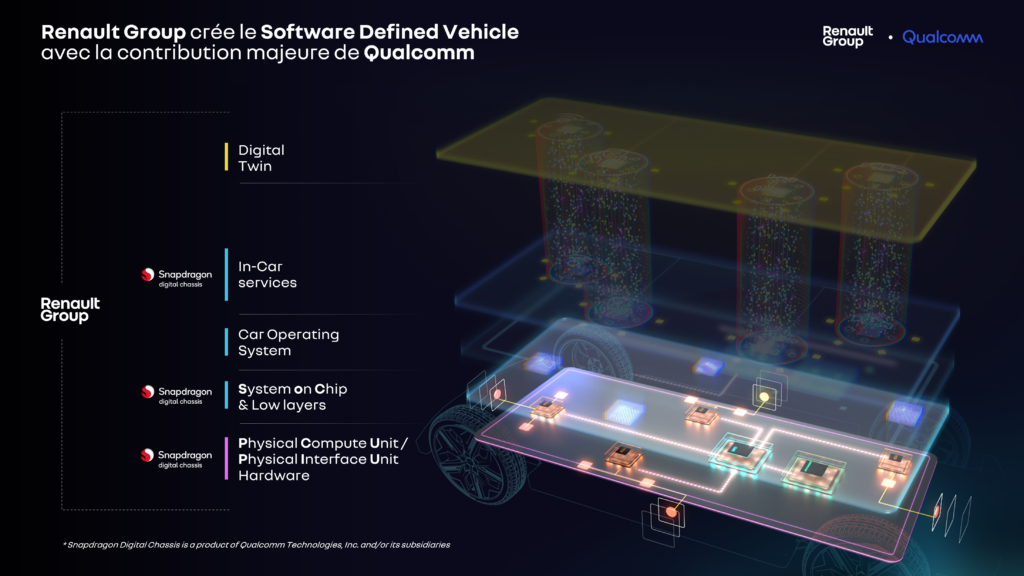
Renault Group and Qualcomm Technologies, Inc. announced that the companies intend to take their technology collaboration one step further with plans to deliver a centralized compute architecture for Renault’s next-generation of software defined vehicles. Known as ‘Software-Defined Vehicle (SDV) Platforms,’ the high-performance automotive platforms would be based on Snapdragon® Digital Chassis™ solutions from Qualcomm Technologies, Inc. and support digital cockpit, connectivity, and advanced driver assistance systems (ADAS). The companies also announced that Qualcomm Technologies, or one of its affiliates, will also be investing in the Renault Group’s dedicated electric and software company, known as Ampere.
“From the mobile to the car with advanced and revolutionary technology, the Software Defined Vehicle is the future of the automotive industry: it is about meeting expectations in terms of functionality and services while controlling complexity and costs. Renault Group is strengthening its strategic collaboration with Qualcomm Technologies, a major mobile and automotive technology player, to bring the first open and horizontal Software Defined Vehicle platform to the automotive market. The combination of Renault Group’s expertise in automotive technology and Qualcomm Technologies’ proven leadership in the high-performance low power semiconductors, software and systems platforms will enable us to provide a scalable, competitive and innovative software-defined vehicle platform foundation to drive the services ecosystem and deliver value to our customers”. Luca de Meo, CEO Renault Group
“Qualcomm is very proud of its relationship with the Renault Group and the expansion of our collaboration to jointly define the car of the future with leading semiconductors, software and services. We are thrilled to have our Snapdragon Digital Chassis solutions play a pivotal role in ushering in their next generation of software-defined vehicles and help accelerate the digital transformation of the automobile.” Cristiano Amon, President and CEO, Qualcomm Incorporated.
Powering the “Software Defined Vehicle” with advanced technology solutions. As an extension of ongoing technology collaborations between the companies, Renault Group and Qualcomm Technologies plan to deliver next-generation SDV architecture that leverages extensible and flexible solutions to address the evolving needs and requirements for vehicles.
From 2026, Renault vehicles will utilize the SDV platform, including new generations of the Snapdragon Digital Chassis, designed to power new Android cockpits and make the on-board experience more immersive and personal; and centralize other vehicle functions, such as advanced driver assistance (ADAS), body, chassis, telematics, connectivity, Power Line Communications (PLC), safety and cybersecurity in the Physical Computer Unit (PCU). This will optimize hardware and software costs, allowing connection to the Physical Interface Unit (PIU), which provides the zonal interface with the vehicle’s actuators. In parallel, the SDV architecture is designed to be open to other vehicle manufacturers.
Sourcing agreement: to optimize the costs of the ‘Software Defined Vehicle’. By working with Qualcomm Technologies, one of the world leaders in semiconductors and software, Renault Group aims to optimize its development and commercialization plans through a co-development approach, which provides the right system level platform capabilities for hardware, software and services.
The growing technological collaboration between Renault Group and Qualcomm Technologies started in 2018. Since, Renault has featured Snapdragon Cockpit Platforms in the Renault Megane E-Tech Electric’s OpenR Link multimedia system and has plans to utilize Snapdragon Digital Chassis solutions to deliver seamless connectivity and intelligent in-car experiences to their drivers and passengers.
About Renault Group
Renault Group is at the forefront of reinventing mobility. Backed by its alliance with Nissan and Mitsubishi Motors, and its unique expertise in terms of electrification, Renault Group draws on the complementary nature of its four brands – Renault – Dacia – Alpine and Mobilize – to offer its customers sustainable and innovative mobility solutions. With operations in more than 130 countries, the Group sold 2.7 million vehicles in 2021. It employs nearly 111,000 people who embody its raison d’être on a daily basis, so that mobility brings us closer to one another. Ready to take up challenges on the road as well as in competition, the Group is committed to an ambitious and value-generating transformation. This is centred on the development of new technologies and services, and a new range of even more competitive, balanced and electrified vehicles. In line with environmental challenges, Renault Group’s ambition is to achieve carbon neutrality in Europe by 2040.
https://www.renaultgroup.com/e
About Qualcomm
Qualcomm is the world’s leading wireless technology innovator and the driving force behind the development, launch, and expansion of 5G. When we connected the phone to the internet, the mobile revolution was born. Today, our foundational technologies enable the mobile ecosystem and are found in every 3G, 4G and 5G smartphone. We bring the benefits of mobile to new industries, including automotive, the internet of things, and computing, and are leading the way to a world where everything and everyone can communicate and interact seamlessly.
Qualcomm Incorporated includes our licensing business, QTL, and the vast majority of our patent portfolio. Qualcomm Technologies, Inc., a subsidiary of Qualcomm Incorporated, operates, along with its subsidiaries, substantially all of our engineering, research and development functions, and substantially all of our products and services businesses, including our QCT semiconductor business.











More Stories
What You Should Know Before Filing a Car Accident Claim
Injured in a Car Accident in St. Louis? Here’s What to Do Next
Historic Sportscar Racing (HSR) and Goodyear Announce Multi-Year Partnership